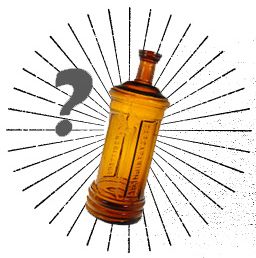Dr. Rogers and His Bottles
For bottle collectors, this one is something of an oddity thanks first to the odd word “Canchalagua” but also to its shape. Sizewise, the body of the bottle is a bit larger than most rectagular patent medicines and to the trained eye it will stand out from the crowd. The embossing is A.L. SCOVILL (side) / DR. A. ROGERS / LIVERWORT TAR / & CANCHALAGUA (front) and CINCINNATI (side).
Examples of this bottle are found with both smooth base and with pontil marks. Those with the pontil mark are embossed with NEW YORK instead of CINCINNATI. Almost all are found in aqua – a few are found in a deep blue-green aqua and command a much higher price as a result.
Laura Crowley writes about Dr. J. Kearney Rogers of New York City who was marketing this medicine from the grand Gothic Hall Building in 1851. She notes the building was torn down in 1856 which leads one to wonder – was it demolished because of neglect or simply because the property had become valuable enough to put a much larger building in its place? Was this a low-rent ruse or a fashionably expensive location?
In any event, Amon L. Scovill came to New York in the 1850s already a prosperous druggist and acquired several products including Dr. Rogers Liverwort, Tar and Canchalagua as well as Hall’s Balsam for the Lungs.
This web page seems to contradict Crowley by stating ths Scovill and a Henry Morrill were in partnership in 1849 selling the Dr. Rogers product in New York. Unfortunately, this person does not cite a source. He goes on to say that Scovill seems to have exited the firm by 1862 and returns again in 1867. This leads me to wonder whether the smooth base bottles which are marked Cincinnati are perhaps from this 5 year period – perhaps Scovill returned home and marketed his product for a time?
John F. Henry took over the brand in the early 1870s. Apparently, the company changed hands at least once again because I found that in 1919, the Williams Company of Cleveland, Ohio was charged for having shipped a case of this “misbranded” medicine. Federal authorities seized the shipment, claiming it was misbranded as specified by the Pure Food and Drug Act of 1906. Analysis of a sample showed that it consisted of “a sweetened aqueous solution containing small amounts of plant extractives, tar extractives, salicylates, alcohol and glycerin.” Apparently, the company got in hot water over their claims to “permanent relief of those Affections of the Throat, Lungs and Liver” ie. suggestive of a cure which was not allowed under the Act.
I do not know how long the product remained in production, but would not be surprised to find that the Federal inquiry led to its demise.
A Few Facts about Dr. Rogers Liverwort, Tar and Canchalagua
– In 1901, The Pharmaceutical Era reported that this product cost $1 per bottle or $7.50 per dozen.
– There were three pontilled (New York) examples in the Sam Greer collection – Lots 1468, 1469 and 1470.
– Examples are found embossed with both “NEW YORK” and “CINCINNATI” on the side panel.
– Most bottles are aqua. A few are known in a deep blue-green aqua color.
– Liverwort (Hepatica americana) is known an herbal remedy for liver disorder, indigestion, coughs, lung and respiratory issues. Here is a modern liquid extract of the plant offered for sale.
– Canchalagua is a South American plant in the Sunflower family and is used as an herbal remedy. It is know for its positive affect on blood, liver and kidney functions. Note that an entirely different plant in a different family which is native to North America shares this same common plant name.
